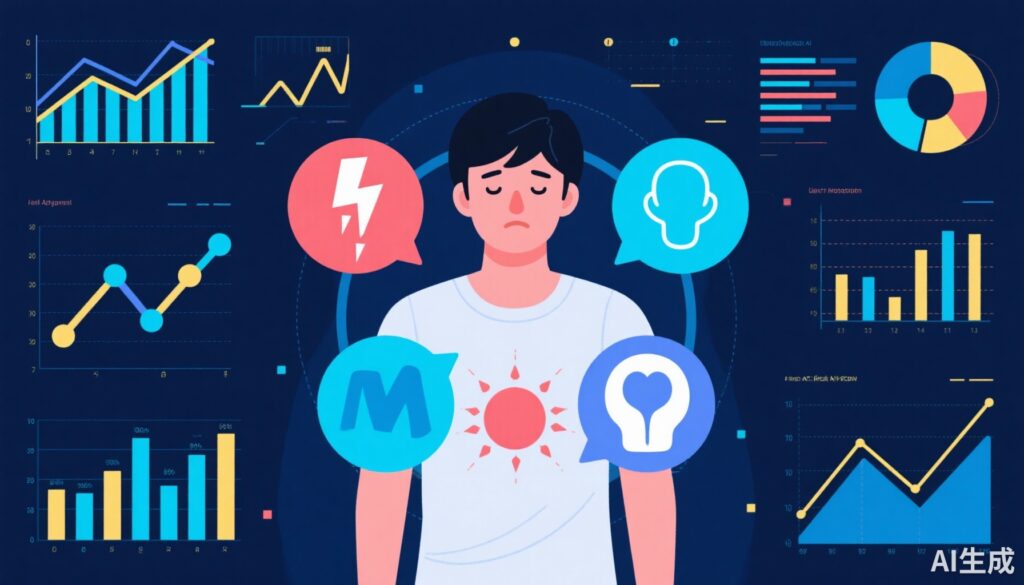Introduction
Chronic pain and psychological distress are prevalent conditions that significantly impair health and well-being, particularly among young adults. These conditions often occur simultaneously, compounding their impact and complicating diagnosis and management. Despite their individual significance, the factors associated with their co-occurrence remain poorly understood, especially in younger populations. Current research indicates that shared biological, psychological, and social factors influence these conditions, but the complex interplay calls for advanced analytical methods capable of handling multidimensional data.
Recent advances in machine learning (ML) and explainable artificial intelligence (AI) have revolutionized the way we analyze healthcare data, enabling the identification of intricate patterns and subgroups that traditional statistical methods might overlook. This article reviews a study that leverages these technologies to elucidate the factors linked to chronic pain, psychological distress, and their co-occurrence among Norwegian young adults. The findings aim to enhance early detection strategies and inform targeted interventions, addressing an unmet clinical need.
Study Design and Methods
The study utilized cross-sectional data from the Norwegian Students’ Health and Well-being Study (SHoT2018), encompassing 34,469 participants with a mean age of 22.9 years, of which 67.4% were female. Participants provided comprehensive data on health, lifestyle, social factors, and psychological parameters.
Three distinct machine learning classification models—Logistic Regression, Tsetlin Machine, and CatBoost—were independently trained to distinguish each of three mutually exclusive groups: individuals with chronic pain only, psychological distress only, and those with both conditions, compared against a healthy control group. The models’ performance was evaluated using the Area Under the Curve (AUC) metric and validated through internal-external cross-validation across different geographical regions.
To interpret the models, the researchers employed Shapley values for feature importance and odds ratios to quantify associations. Additionally, logical clause rules derived from the models facilitated identification of variable clusters and potential latent subgroups.
Major Results and Findings
The prevalence rates within the study cohort were 27.2% for chronic pain, 12.7% for psychological distress, and 26.7% for their co-occurrence. The performance of the models was robust and consistent across regions, with AUCs ranging from 0.70 to 0.72 for chronic pain, 0.92 to 0.93 for psychological distress, and 0.94 to 0.96 for the co-occurring group.
Explainable AI analyses identified key associated factors across all conditions, notably gender (females), perceived overall health, and sleep disorders. Interestingly, the pattern of factors differed when analyzing conditions individually versus in combination. Certain factors appeared to negate each other’s influence in the co-occurring group, while others exhibited additive effects—with some factors amplifying risk more significantly in the presence of both conditions.
These insights reveal that the co-occurrence of chronic pain and psychological distress reflects a distinct pathophysiological and psychosocial profile, not merely the sum of individual factors. Identifying such patterns is crucial for early intervention, potentially allowing healthcare providers to stratify risk and personalize management plans.
Expert Commentary
These findings embody the advancing frontier of precision medicine in mental and musculoskeletal health. The use of machine learning and explainable AI enhances our understanding of complex comorbidities, which traditional methods may obscure. The study’s rigorous validation strengthens confidence in the identified associations.
However, limitations include its cross-sectional nature, which precludes causal inferences, and the reliance on self-reported data, susceptible to biases. Furthermore, while the models perform well within this Norwegian population, generalizability to other ethnicities and age groups warrants further research.
The distinct patterns observed in co-occurring conditions highlight the need for integrated assessment strategies in clinical practice, emphasizing gender-specific and psychosocial factors. Future longitudinal studies should explore causality and evaluate whether interventions targeting identified factors can reduce the incidence or severity of these conditions.
Conclusion
This study exemplifies the potential of machine learning and explainable AI to unravel the multifaceted associations underlying chronic pain, psychological distress, and their co-occurrence in young adults. Recognizing unique risk profiles facilitates earlier detection and personalized preventive strategies, ultimately improving health outcomes. Continued research integrating computational approaches promises to advance our understanding and management of complex health conditions.
Funding and References
Funding details were not specified in the original study. References include key literature on comorbid chronic pain and psychological distress, as well as recent methodological advances in AI applications in healthcare.
{“name”: “Gorosito MA, Haugerud H, Berg B, Yazidi A, Øiestad BE, Sivertsen B, Grotle M, Rønn Richardsen K. Chronic pain, psychological distress, and their co-occurrence in Norwegian young adults: Insights from machine learning and explainable AI. Int J Med Inform. 2026 Jan;205:106108. doi: 10.1016/j.ijmedinf.2025.106108. Epub 2025 Sep 10. PMID: 40939305.”}



